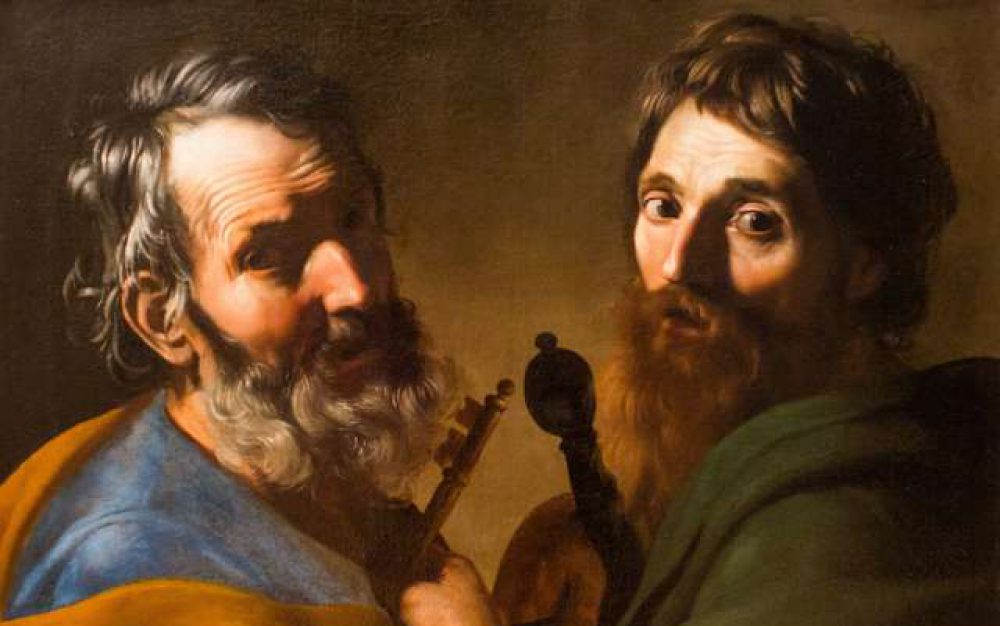Saint of the Day – 12 June – St Pope Leo III (c 750-816) Bishop of Rome and Ruler of the Papal States from 26 December 795 to his death, Diplomat, financial administrator and Defender of the City ad peoples of Rome and of the Church. Peacemaker and restorer of Churches and Monasteries, Patron of the Arts and apostle of the poor. Known as “Charlemagne’s Pope” Born at Rome, Italy in c 750 and died on 12 June 816.
The Roman Martyrology statesof him today: “At Rome, in the Vatican Basilica, St Leo III, to whom God miraculously restored his eyes and his tongue, after they had been torn out by impious men.”
Leo was of a modest family in southern Italy, the son of Atyuppius and Elizabeth. He was made Cardinal-Priest of Santa Susanna by Pope Adrian I, and also Vestiarius, or Chief of the Pontifical Treasury, or wardrobe.
He was elected on 26 December 795, the day Adrian I was buried and Consecrated on the following day. With the letter informing Charlemagne that he had been unanimously elected Pope, Leo sent him the keys of the cCnfession of St Peter and the Standard of the City. This he did, to show that he regarded the Frankish King as the Protector of the Holy See. In return he received from Charlemagne, letters of congratulation and a great part of the treasure which the King had captured from the Avars. The acquisition of this wealth, was one of the causes which enabled Leo to be such a great benefactor to the Churches and charitable institutions of Rome.
Prompted by jealousy or ambition, or by feelings of hatred and revenge, a number of the relatives of Pope Adrian I formed a plot to render Leo unfit to hold his sacred office. On the occasion of the procession of the Greater Litanies (25 April, 799), when the Pope was making his way towards the Flaminian Gate, he was suddenly attacked by a body of armed men. He was dashed to the ground and an effort was made to root out his tongue and tear out his eyes. After he had been left for a time bleeding in the street, he was hurried off at night to the Monastery of St Erasmus (remeber St Elmo?)on the Cœlian. There, in what seemed quite a miraculous manner, he recovered the full use of his eyes and tongue. Escaping from the Monastery, he betook himself to Charlemagne, accompanied by many of the Romans. He was received by the Frankish King with the greatest honour at Paderborn, although his enemies had filled the King’s ears with malicious accusations against him. After a few months’ stay in Germany, the Frankish Monarch caused him to be escorted back to Rome, where he was received with every demonstration of joy by the whole populace, natives and foreigners.
The Pope’s enemies were then tried by Charlemagne’s envoys and, being unable to establish either Leo’s guilt or their own innocence, were sent as prisoners to France (Frankland). In the following year (800) Charlemagne himself came to Rome and the Pope and his accusers were brought face to face. The assembled Bishops declared that they had no right to judge the Pope;but Leo of his own free will, in order, as he said, to dissipate any suspicions in men’s minds, declared on oath, that he was wholly guiltless of the charges which had been brought against him. At his special request, the death sentence which had been passed upon his principal enemies, was commuted into a sentence of exile.
A few days later, Leo and Charlemagne again met. It was on Christmas Day in St. Peter’s. After the Gospel had been sung, the Pope approached Charlemagne,, who was kneeling before the Confession of St Peter,and placed a Crown upon his head. The assembled multitude at once made the Basilica ring with the shout: “To Charles, the most pious Augustus, crowned by God, to our great and pacific Emperor life and victory!” By this act was revived the Empire in the West and, in theory, at least, the world was declared by the Church, subject to one temporal head, as Christ had made it subject to one spiritual head.

It was understood that the first duty of the new Emperor was to be the Protector of the Roman Church and of Christendom against the heathen. With a view to combining the East and West under the effective rule of Charlemagne, Leo strove to further the project of a marriage between him and the Eastern Empress Irene. Her deposition, however (801), prevented the realisation of this excellent plan. Some three years after the departure of Charlemagne from Rome (801), Leo again crossed the Alps to see him (804). According to some he went to discuss with the Emperor ,the division of his territories between his sons. At any rate, two years later, he was invited to give his assent to the Emperor’s provisions for the said partition. Equally while acting in harmony with the Pope, Charlemagne combatted the heresy of Adoptionism which had arisen in Spain but he went somewhat further than his spiritual guide when he wished to bring about the general insertion of the Filioque in the Nicene Creed. The two were, however, acting together when Salzburg was made the metropolitical City for Bavaria and when Fortunatus of Grado was compensated for the loss of his See of Grado by the gift of that of Pola. The joint action of the Pope and the Emperor was felt even in England. Through it, Eardulf of Northumbria recovered his Kingdom, and the dispute between Eanbald, Archbishop of York and Wulfred, Archbishop of Canterbury, was regulated.
Leo had, however, many relations with England solely on his own account. By his command, the Synod of Beccanceld (or Clovesho, 803), condemned the appointing of laymen as superiors of Monasteries. In accordance with the wishes of Ethelheard, Archbishop of Canterbury, Leo excommunicated Eadbert Praen for seizing the throne of Kent and withdrew the pallium which had been granted to Litchfield, authorising the restoration of the ecclesiastical jurisdiction of the See of Canterbury “just as St. Gregory the Apostle and Master of the nation of the English had arranged it”.
During the Pontificate of Leo, the Church of Constantinople was in a state of unrest. In their distress, the Monks turned for help to Leo, as they had done earlier. The Pope replied, not merely with words of praise and encouragement but also, by the dispatch of rich presents and, after Michael I came to the Byzantine throne, he ratified the treaty between him and Charlemagne which was to secure peace for East and West.
Not only in the last mentioned transaction but in all matters of importance, did the Pope and the Charlemagne act in concert. It was on Charlemagne’s advice that, to ward off the savage raids of the Saracens, Leo maintained a fleet,and caused his coast line to be regularly patrolled by his ships of war. But because he did not feel competent to keep the Moslem pirates out of Corsica, he entrusted the guarding of it to the Emperor.
But when the great Emperor died (28 January 814), evil times once more broke on Leo. A fresh conspiracy was formed against him but on this occasion the Pope was apprised of it before it came to a head. He caused the chief conspirators to be seized and executed. No sooner had this plot been crushed than a number of nobles of the Campagna rose in arms and plundered the country. They were preparing to march on Rome itself, when they were overpowered by the Duke of Spoleto, acting under the orders of the King of Italy (Langobardia).
The large sums of money which Charlemagne had given to the Papal Treasury enabled Leo to become an efficient helper of the poor and a patron of art, and to renovate the Churches, not only of Rome, but even of Ravenna. He employed the imperishable art of mosaic not only to portray the political relationship between Charlemagne and himself but chiefly, to decorate the Churches, especially his titular Church of St Susanna. Up to the end of the sixteenth century a figure of Leo in mosaic was to be seen in that ancient church.
Leo III was buried in St Peter’s (12 June, 816), where his relics are to be found along with those of Sts Leo I, Leo II and Leo IV. He was Canonised in 1673 by Pope Clement X. The silver denarii of Leo III still extant, bears the name of the Frankish Emperor upon them, as well as that of Leo, showing thereby the Emperor as the Protector of the Church and overlord of the City of Rome.





3 thoughts on “Saint of the Day – 12 June – St Pope Leo III (c 750-816)”